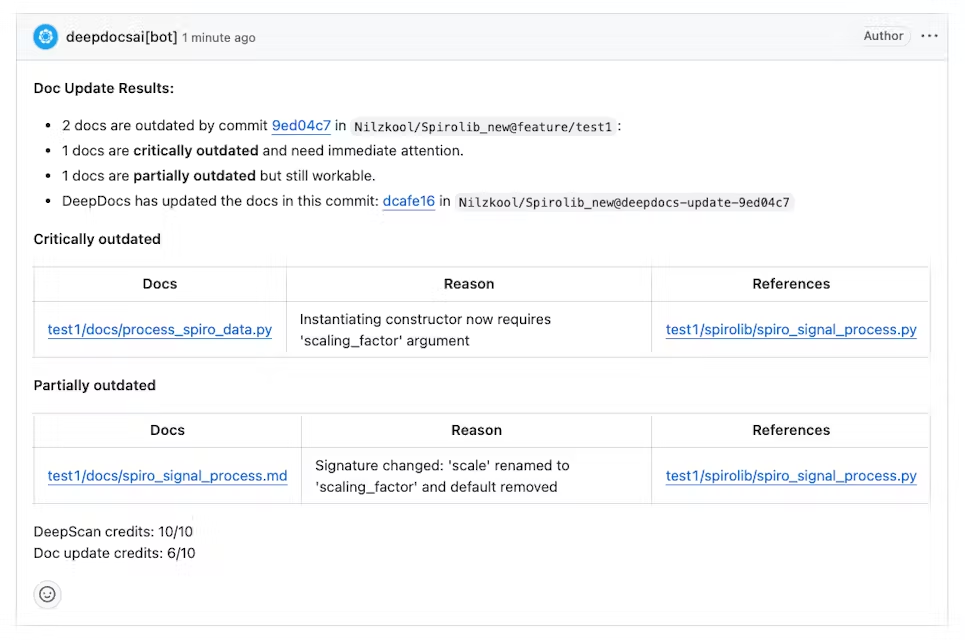DeepDocs is a GitHub-based AI tool focused on solving the problem of cumbersome code documentation updates. It intelligently analyzes code changes and automatically updates project documentation such as READMEs, API references, and tutorials to ensure that it stays in sync with the code.DeepDocs integrates into GitHub workflows without the need for additional platforms, making it ideal for fast-paced development teams. It scans the entire codebase, identifies out-of-date documentation, and accurately updates it without changing its format or style. With simple configuration, users can automate document management, reducing the need for manual maintenance, and DeepDocs emphasizes privacy, as code is only processed temporarily at runtime and is not stored.

Function List
- Ongoing Documentation Updates: Automatically detect and update affected documents after each code commit.
- deep scan: Fully analyze the code base and batch fix all outdated documentation.
- intelligent editor (software): Update only the necessary parts of the document, retaining the original structure and style.
- Detailed report: Generate a change report describing the reason for the documentation update and the associated code commit.
- GitHub Native Integration: Embed directly into GitHub workflows to create separate branches to commit document updates.
- Support for multiple document types: Compatible with READMEs, API references, SDK guides, tutorials and more.
- Privacy: Code processing is temporary and not stored, guaranteeing data security.
Using Help
Installation process
DeepDocs is very easy to install and configure for any development team using GitHub. Here are the detailed installation steps:
- Installing the DeepDocs GitHub App
Open your GitHub repository and go toSettings > GitHub Apps. Search the GitHub MarketplaceDeepDocsAIClickConfigure.. Select the code repository that needs to be monitored (if the documentation is in a separate repository, it needs to be installed to that repository as well). ClickSaveSave the configuration. If you need to add more repositories, you can do so later in GitHub'sInstallation SettingsAdjustment in the middle. - Creating Configuration Files
In the root directory of the code repository, create a file nameddeepdocs.ymlfile. The following is an example of a basic configuration:target: - url: "docs/" reinit: "random-string" ignore: []target: Specify the document folder or file path to be monitored, such asdocs/Thereinit: A random string used to manually trigger a depth scan.ignore: Specify files or folders to ignore (optional).
Commit this file to the branch to be monitored (e.g.mainmaybedev).
- Trigger Initial Scan
submit (a report etc)deepdocs.ymlAfter that, DeepDocs automatically triggers a deep scan that analyzes the entire codebase and updates outdated documentation. The results are committed to a new branch nameddeepdocs-deepscan-<branch>-<commit_sha>with an updated report.
Using the main functions
Ongoing Documentation Updates
The core feature of DeepDocs is continuous documentation updates. After each code commit (push or pull request), DeepDocs automatically scans the code for changes and determines which documentation needs to be updated. For example, if an API endpoint is modified, DeepDocs will update the relevant API reference documentation. The updates are committed to a new branch (e.g., the deepdocs-update-<branch>-<commit_sha>) that contain detailed change reports. Users can review and merge these updates directly on GitHub.
deep scan
Deep scanning is suitable for handling large numbers of outdated documents. Users can modify the deepdocs.yml hit the nail on the head reinit string and commit, triggering a full scan.DeepDocs examines the entire codebase, identifies all documents that need to be updated, and generates a branch containing all changes. The report lists the updated documents, the reason for the change, and the associated code commits.
Intelligent Editing and Reporting
DeepDocs uses AI to analyze the code in relation to the documentation, updating only the necessary parts. For example, if a function signature changes, DeepDocs only updates the description of the associated documentation without rewriting the entire file. Each update generates a report that describes which documents were changed, why, and the associated code commits. This allows teams to quickly verify the accuracy of updates.
GitHub Native Integration
DeepDocs is embedded directly into GitHub workflows without additional tools. It runs through GitHub Actions and monitors pull requests and code commits. Updated documentation is submitted as a pull request, making it easy for teams to review. Users can do everything without leaving GitHub.
workflow
- Submit Code: Developers normally commit code to GitHub repositories.
- automatic detection: DeepDocs detects code changes and analyzes the impact on documentation.
- Generate Updates: DeepDocs commits updated documentation and reports in a new branch.
- Review and consolidation: The team reviews the pull request on GitHub, confirms it, and merges it.
- Manual Depth Scan(Optional): Modify
reinitstring that triggers a full document fix.
caveat
- If the documents and code are in different repositories, make sure the DeepDocs app is installed in both repositories, but only configure the code repository with
deepdocs.ymlThe - DeepDocs does not generate a brand new document, it requires an initial document (e.g., via the GitHub Copilot (Created).
- Documentation updates respect the original Markdown format, suitable for open source projects or internal teams.
application scenario
- Open Source Project Maintenance
Open source projects often have a large number of contributors, frequent code updates, and out-of-date documentation. DeepDocs automatically synchronizes the documentation, reducing the burden on maintainers to manually update it and ensuring that new developers can quickly understand the latest code and APIs. - Rapidly iterative development team
Rapid development teams, such as startups, focus on feature development and documentation is often overlooked.DeepDocs automatically updates README and API documentation, allowing teams to focus on coding while keeping documentation accurate. - Multi-warehouse project management
DeepDocs supports cross-repository synchronization for large projects where code and documents are stored separately. It monitors code repository changes and updates content in the document repository for microservice architecture teams. - Technical debt clearance
Older projects often have a lot of outdated documentation, and DeepDocs' deep scanning feature fixes it all at once, generating clear change reports that help teams quickly clear technical debt.
QA
- Does DeepDocs change the formatting or style of the document?
No. DeepDocs only updates the portion of the documentation that relates to the code change, preserving the original formatting, tone, and structure. - What types of documents does DeepDocs support?
Supports documentation in Markdown format, including READMEs, API references, SDK guides and tutorials, suitable for most technical documentation. - How do I trigger a deep scan?
modificationsdeepdocs.ymlhit the nail on the headreinitstring and commit, DeepDocs scans the entire codebase and updates outdated documentation. - Does DeepDocs store my code?
No. DeepDocs only temporarily processes code at runtime and does not store it after processing, ensuring privacy and security. - Does DeepDocs require initial documentation?
Yes. DeepDocs does not generate brand new documentation, it needs to have initial documentation first. It focuses on keeping existing documentation synchronized with the code.

































